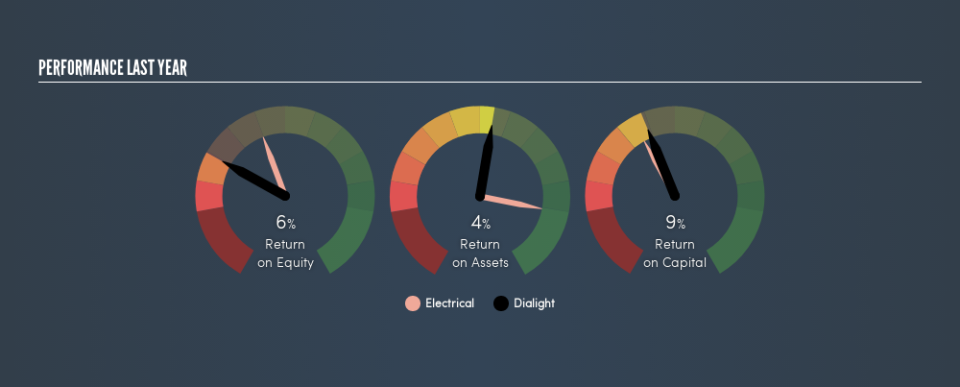Why You Should Care About Dialight plc’s (LON:DIA) Low Return On Capital

Today we'll look at Dialight plc (LON:DIA) and reflect on its potential as an investment. In particular, we'll consider its Return On Capital Employed (ROCE), as that can give us insight into how profitably the company is able to employ capital in its business.
First of all, we'll work out how to calculate ROCE. Then we'll compare its ROCE to similar companies. Then we'll determine how its current liabilities are affecting its ROCE.
What is Return On Capital Employed (ROCE)?
ROCE is a metric for evaluating how much pre-tax income (in percentage terms) a company earns on the capital invested in its business. In general, businesses with a higher ROCE are usually better quality. Overall, it is a valuable metric that has its flaws. Renowned investment researcher Michael Mauboussin has suggested that a high ROCE can indicate that 'one dollar invested in the company generates value of more than one dollar'.
How Do You Calculate Return On Capital Employed?
Analysts use this formula to calculate return on capital employed:
Return on Capital Employed = Earnings Before Interest and Tax (EBIT) ÷ (Total Assets - Current Liabilities)
Or for Dialight:
0.093 = UK£8.0m ÷ (UK£123m - UK£38m) (Based on the trailing twelve months to December 2018.)
Therefore, Dialight has an ROCE of 9.3%.
Want to participate in a short research study? Help shape the future of investing tools and you could win a $250 gift card!
See our latest analysis for Dialight
Does Dialight Have A Good ROCE?
ROCE can be useful when making comparisons, such as between similar companies. Using our data, Dialight's ROCE appears to be significantly below the 14% average in the Electrical industry. This performance is not ideal, as it suggests the company may not be deploying its capital as effectively as some competitors. Separate from Dialight's performance relative to its industry, its ROCE in absolute terms looks satisfactory, and it may be worth researching in more depth.
It is important to remember that ROCE shows past performance, and is not necessarily predictive. ROCE can be deceptive for cyclical businesses, as returns can look incredible in boom times, and terribly low in downturns. This is because ROCE only looks at one year, instead of considering returns across a whole cycle. What happens in the future is pretty important for investors, so we have prepared a free report on analyst forecasts for Dialight.
What Are Current Liabilities, And How Do They Affect Dialight's ROCE?
Short term (or current) liabilities, are things like supplier invoices, overdrafts, or tax bills that need to be paid within 12 months. Due to the way ROCE is calculated, a high level of current liabilities makes a company look as though it has less capital employed, and thus can (sometimes unfairly) boost the ROCE. To check the impact of this, we calculate if a company has high current liabilities relative to its total assets.
Dialight has total liabilities of UK£38m and total assets of UK£123m. Therefore its current liabilities are equivalent to approximately 31% of its total assets. Dialight has a medium level of current liabilities, which would boost the ROCE.
The Bottom Line On Dialight's ROCE
Dialight's ROCE does look good, but the level of current liabilities also contribute to that. Dialight shapes up well under this analysis, but it is far from the only business delivering excellent numbers . You might also want to check this free collection of companies delivering excellent earnings growth.
For those who like to find winning investments this free list of growing companies with recent insider purchasing, could be just the ticket.
We aim to bring you long-term focused research analysis driven by fundamental data. Note that our analysis may not factor in the latest price-sensitive company announcements or qualitative material.
If you spot an error that warrants correction, please contact the editor at editorial-team@simplywallst.com. This article by Simply Wall St is general in nature. It does not constitute a recommendation to buy or sell any stock, and does not take account of your objectives, or your financial situation. Simply Wall St has no position in the stocks mentioned. Thank you for reading.

